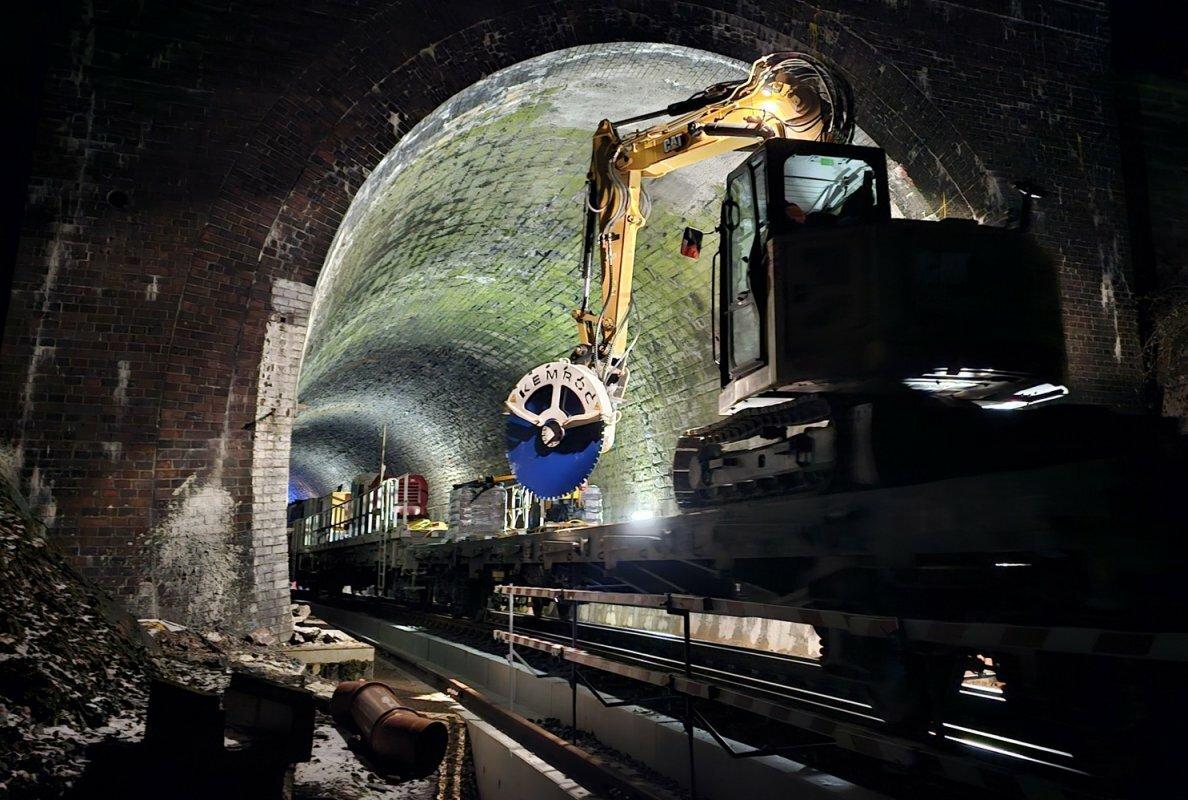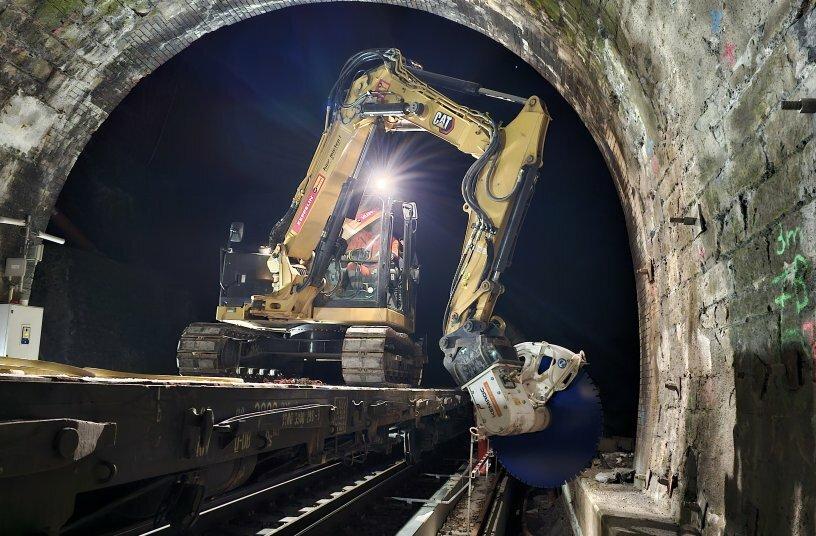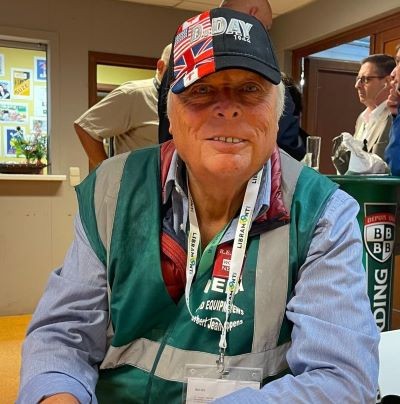KEMROC-Cable ducts removed quickly
 26/06/24-FR-English-NL-footer
26/06/24-FR-English-NL-footer
KEMROC-Gains de câbles retirés rapidement

 An 8-ton excavator with a KDS 30 diamond saw enters the Elleringhauser Tunnel on a platform truck. The task is to cut concrete cable ducts at the bottom of the tunnel walls. IMAGE SOURCE: KEMROC-The operator positions the excavator perpendicular to the axis of the tunnel and positions the KEMROC diamond saw on the cable duct at intervals of 150 cm.
An 8-ton excavator with a KDS 30 diamond saw enters the Elleringhauser Tunnel on a platform truck. The task is to cut concrete cable ducts at the bottom of the tunnel walls. IMAGE SOURCE: KEMROC-The operator positions the excavator perpendicular to the axis of the tunnel and positions the KEMROC diamond saw on the cable duct at intervals of 150 cm.
IMAGE SOURCE: KEMROC
Le tunnel d'Elleringhauser en Allemagne fait l'objet d'une rénovation complète nécessitant la suppression des goulottes de câbles en béton.
Le consortium EET, composé de Max Bögl, Marti DE et Marti CH, exécute la rénovation en utilisant la méthode tunnel dans tunnel afin d'éviter des fermetures prolongées.
Une pelle compacte de 8 tonnes équipée d'une scie diamantée KEMROC KDS 30 a été choisie pour son adéquation à l'espace étroit du tunnel et aux contraintes opérationnelles.
La scie diamantée KEMROC KDS 30, connue pour couper divers matériaux, s'est avérée efficace pour couper les conduits en béton de manière rapide et efficace.
Le processus de découpe impliquait l'installation de la scie diamantée à intervalles réguliers, la découpe du conduit, puis l'utilisation d'un marteau hydraulique et d'une pince pour retirer les sections de béton.
Le projet a été réalisé plus rapidement que prévu, validant le choix des équipements et démontrant la polyvalence des accessoires KEMROC.
Le tunnel d’Elleringhauser, dans la région allemande du Hoch Sauerland, est entièrement rénové. Pour installer le nouveau revêtement du tunnel, des goulottes de câbles en béton ont dû être retirées du bas de la paroi du tunnel. Les spécialistes du consortium EET (Max Bögl/Marti DE/Marti CH) ont choisi une pelle compacte de 8 tonnes et une scie diamantée KEMROC KDS 30 pour couper les conduits en béton en morceaux maniables.
Le tunnel d'Elleringhauser dans le Hoch Sauerland (Rhénanie du Nord-Westphalie) a une longue histoire. Le tunnel ferroviaire de près de 1 400 m de long près d'Olsberg et de Brilon fait partie du chemin de fer de la haute vallée de la Ruhr, qui relie Aix-la-Chapelle à Kassel. Entre 1868 et 1872, le tunnel fut construit sous forme d'un tube unique à double voie. Le tunnel – une structure classique en maçonnerie en forme de fer à cheval – doit être rénové après près de 150 ans d'utilisation. Trois entreprises contractantes Max Bögl Stiftung & Co. KG, Marti GmbH Deutschland et Marti Tunnel AG ont uni leurs forces pour former le tunnel ARGE Elleringhauser (consortium EET).
La plupart des travaux de rénovation seront réalisés selon la méthode dite du tunnel dans le tunnel, qui évite une fermeture complète sur de longues périodes. Dans un premier temps, la maçonnerie existante sera profilée avant d'installer un nouveau revêtement de tunnel préfabriqué. Afin de créer l'espace nécessaire pour le nouveau revêtement du tunnel, les goulottes de câbles en béton existantes pour la technique de signalisation et d'éclairage situées des deux côtés du sol du tunnel doivent d'abord être supprimées.
L'ingénieur diplômé Thomas Töpfer, ingénieur en mécanique chez Max Bögl, partenaire d'ARGE, a expliqué la logique derrière le choix de l'équipement : « L'utilisation d'une excavatrice avec une cisaille à béton ou un pulvérisateur était hors de question en raison du manque de place dans ce tunnel aux parois étroites. profil de dégagement. De plus, les travaux de rénovation ont lieu uniquement la nuit, entre 22h00 et 5h00 du matin, lorsque la voie ferrée est en service. Par conséquent, la méthode standard de carottage et de coupe au diamant ou à la scie à fil ne serait pas pratique, car le matériel utilisé devrait être monté et démonté encore et encore." C'est pourquoi les participants au consortium ont opté pour une solution inhabituelle dans la construction de tunnels : l'utilisation de la technologie des scies diamantées sous la forme d'une mini-pelle louée avec une scie diamantée de la gamme d'accessoires KDS du fabricant KEMROC.
Coupes rapides
Les scies diamantées KDS de KEMROC sont conçues pour couper une grande variété de matériaux, notamment la pierre naturelle, le granit, le béton armé, le béton, l'asphalte, les plastiques, le bois, les feuilles et l'aluminium. Montés sur des pelles sur chenilles ou sur pneus et connectés à leur circuit hydraulique, les accessoires offrent des performances élevées dans de nombreux secteurs industriels avec de très faibles contraintes pour le porteur, l'opérateur ou l'environnement. Des vitesses de rotation élevées et une sélection de meules diamantées rendent ces accessoires très efficaces dans une large gamme d'applications.
Lors du projet de rénovation du tunnel d'Elleringhauser, la pelle compacte de 8 t associée à une combinaison de scie diamantée KEMROC KDS 30 (puissance nominale de 80 kW) s'est révélée très pratique : d'une part, la pelle compacte était suffisamment petite pour se déplacer en toute sécurité dans le tunnel coupe transversale. D'autre part, la scie diamantée dispose d'une molette de diamètre suffisamment grand pour couper complètement le conduit en béton (hauteur x profondeur = 60 x 40 cm).
Le processus de découpe en détail : La mini-pelle est transportée dans le tunnel sur un camion plate-forme. A intervalles de 150 cm, la scie diamantée est installée devant le passage de câbles au pied de la paroi du tunnel. L'opérateur découpe ensuite le conduit de béton de haut en bas, passe au marteau hydraulique et soulève la portion de béton en trois ou quatre coups. Il passe ensuite à une benne et charge le tronçon de béton à retirer du tunnel.
Les travaux de découpe ont duré du 8 au 27 janvier 2024, soit nettement plus rapidement que prévu initialement. Pour Thomas Töpfer, les résultats ont confirmé que le choix de l'équipement était correct : « Nous sommes familiers avec les outils de fraisage et avons de l'expérience dans l'utilisation de la gamme d'équipements KEMROC dans des projets précédents, par exemple dans la construction de tunnels et de routes asphaltées. Il est bon de savoir que le fabricant La gamme comprend également des accessoires qui ne sont pas initialement destinés aux applications de tunnelage, mais ils peuvent constituer la solution idéale dans certains cas comme celui-ci.
NJC.© Info KEMROC Spezialmaschinen GmbH
------------------------------------------------------------------------------------------------------------------
 26/06/24-English
26/06/24-English
KEMROC-Cable ducts removed quickly

 An 8-ton excavator with a KDS 30 diamond saw enters the Elleringhauser Tunnel on a platform truck. The task is to cut concrete cable ducts at the bottom of the tunnel walls. IMAGE SOURCE: KEMROC-The operator positions the excavator perpendicular to the axis of the tunnel and positions the KEMROC diamond saw on the cable duct at intervals of 150 cm.
An 8-ton excavator with a KDS 30 diamond saw enters the Elleringhauser Tunnel on a platform truck. The task is to cut concrete cable ducts at the bottom of the tunnel walls. IMAGE SOURCE: KEMROC-The operator positions the excavator perpendicular to the axis of the tunnel and positions the KEMROC diamond saw on the cable duct at intervals of 150 cm.
IMAGE SOURCE: KEMROC
The Elleringhauser Tunnel in Germany is undergoing a complete renovation, requiring the removal of concrete cable ducts.
The EET consortium, comprising Max Bögl, Marti DE, and Marti CH, is executing the renovation using a tunnel-within-a-tunnel method to avoid prolonged closures.
An 8-tonne compact excavator equipped with a KEMROC KDS 30 diamond saw was chosen for its suitability in the tunnel's narrow space and operational constraints.
The KEMROC KDS 30 diamond saw, known for cutting various materials, proved effective in cutting through the concrete ducting quickly and efficiently.
The cutting process involved setting up the diamond saw at intervals, cutting through the duct, and then using a hydraulic hammer and grab to remove the concrete sections.
The project was completed faster than planned, validating the choice of equipment and showcasing the versatility of KEMROC's attachments.
The Elleringhauser Tunnel in Germany’s Hoch Sauerland region is being completely renovated. To install new tunnel lining, concrete cable ducts had to be removed from the bottom of the tunnel wall. Specialists from the EET consortium (Max Bögl/Marti DE/Marti CH) chose an 8-tonne compact excavator and a KEMROC KDS 30 diamond saw to cut the concrete ducting into manageable pieces.
The Elleringhauser Tunnel in the Hoch Sauerland (North Rhine-Westphalia) has a long history. The almost 1,400 m long railway tunnel near Olsberg and Brilon is part of the Upper Ruhr Valley Railway, which runs between Aachen and Kassel. Between 1868 and 1872, the tunnel was built as a single tube with double track. The tunnel – a classic masonry structure in a horseshoe shape – has to be renovated after almost 150 years of use. Three contracting companies Max Bögl Stiftung & Co. KG, Marti GmbH Deutschland and Marti Tunnel AG joined forces to form the ARGE Elleringhauser Tunnel (EET consortium).
Most of the renovation work will be carried out using the so-called tunnel-within-a-tunnel method, which avoids full closure over longer periods of time. Initially, the existing masonry will be profiled before a new prefabricated tunnel lining will be installed. To create the necessary space for the new tunnel lining, existing concrete cable ducts for signalling and lighting technology located on both sides of the tunnel floor must first be removed.
Dipl.-Ing Thomas Töpfer, mechanical engineer from ARGE partner Max Bögl, explained the logic behind their choice of equipment: "Using an excavator with concrete shearer or pulveriser was out of the question due to the lack of space in this tunnel with its narrow clearance profile. In addition, the renovation work takes place only at night, between 10:00 p.m. and 5:00 a.m., with the railway operating. Therefore, the standard method of core drilling and diamond cutter or wire saws would not be practical, because the equipment used would have to be set up and dismantled over and over again." For this reason, those involved in the consortium opted for a solution that is unusual in tunnel construction – namely the use of diamond saw technology in the form of a rented mini excavator with a diamond saw from the KDS range of attachments from the manufacturer KEMROC.
Fast cuts
KDS diamond saws from KEMROC are designed for cutting a wide variety of materials including natural stone, granite, reinforced concrete, concrete, asphalt, plastics, wood, foils and aluminium. Mounted on crawler or wheeled excavators and connected to their hydraulic circuit, the attachments deliver high performance in many industrial sectors with very low stress to the carrier, operator or the environment. High rotation speeds and a selection of diamond cutting wheels make these attachments very effective in a wide range of applications.
At the Elleringhauser Tunnel renovation project, the 8-t compact excavator with a KEMROC KDS 30 diamond saw (80 kW nominal power) combination proved to be very practical: On the one hand, the compact excavator was small enough to move safely in the tunnel cross-section. On the other hand, the diamond saw has a sufficiently large diameter cutting wheel to cut through the concrete ducting (height x depth = 60 x 40 cm) completely.
The cutting process in detail: The mini excavator is taken into the tunnel on a platform truck. At 150 cm intervals, the diamond saw is set up in front of the cable ducting at the bottom of the tunnel wall. Then the operator cuts through the concrete duct from top to bottom, switches to a hydraulic hammer and lifts off the portion of concrete with three or four blows. He then switches to a grab and loads the concrete section for removal from the tunnel.
The cutting work lasted from January 8 to 27, 2024 – significantly quicker than initially planned. For Thomas Töpfer, the results confirmed that the choice of equipment was correct: "We are familiar with milling attachments and have experience using KEMROC's range of equipment in previous projects, for example in tunnel and asphalt road construction. It's good to know that the manufacturer's range also includes attachments not originally intended for tunnelling applications, but they can be just the right solution in certain cases like this."
NJC.© Info KEMROC Spezialmaschinen GmbH
--------------------------------------------------------------------------------------------------------------------
 26/06/24-NL
26/06/24-NL
KEMROC-Kabelgoten snel verwijderd

 An 8-ton excavator with a KDS 30 diamond saw enters the Elleringhauser Tunnel on a platform truck. The task is to cut concrete cable ducts at the bottom of the tunnel walls. IMAGE SOURCE: KEMROC-The operator positions the excavator perpendicular to the axis of the tunnel and positions the KEMROC diamond saw on the cable duct at intervals of 150 cm.
An 8-ton excavator with a KDS 30 diamond saw enters the Elleringhauser Tunnel on a platform truck. The task is to cut concrete cable ducts at the bottom of the tunnel walls. IMAGE SOURCE: KEMROC-The operator positions the excavator perpendicular to the axis of the tunnel and positions the KEMROC diamond saw on the cable duct at intervals of 150 cm.
IMAGE SOURCE: KEMROC
De Elleringhausertunnel in Duitsland ondergaat een volledige renovatie, waarbij betonnen kabelgoten moeten worden verwijderd.
Het EET-consortium, bestaande uit Max Bögl, Marti DE en Marti CH, voert de renovatie uit met behulp van een tunnel-in-tunnel-methode om langdurige sluitingen te voorkomen.
Er werd gekozen voor een compacte graafmachine van 8 ton, uitgerust met een KEMROC KDS 30 diamantzaag vanwege zijn geschiktheid in de smalle ruimte van de tunnel en de operationele beperkingen.
De KEMROC KDS 30 diamantzaag, bekend om het zagen van verschillende materialen, bleek effectief bij het snel en efficiënt door de betonnen kanalen zagen.
Het zaagproces omvatte het met tussenpozen opstellen van de diamantzaag, het doorsnijden van het kanaal en het vervolgens gebruiken van een hydraulische hamer en grijper om de betondelen te verwijderen.
Het project werd sneller voltooid dan gepland, wat de keuze van de uitrusting bevestigde en de veelzijdigheid van de aanbouwdelen van KEMROC demonstreerde.
De Elleringhausertunnel in de Duitse regio Hoch Sauerland wordt volledig gerenoveerd. Voor het plaatsen van nieuwe tunnelbekleding moesten betonnen kabelgoten aan de onderkant van de tunnelwand worden verwijderd. Specialisten van het EET-consortium (Max Bögl/Marti DE/Marti CH) kozen voor een compacte graafmachine van 8 ton en een KEMROC KDS 30 diamantzaag om de betonnen kanalen in hanteerbare stukken te zagen.
De Elleringhausertunnel in het Hoch Sauerland (Noordrijn-Westfalen) kent een lange geschiedenis. De bijna 1.400 m lange spoortunnel bij Olsberg en Brilon maakt deel uit van de Boven-Ruhrdalspoorlijn, die tussen Aken en Kassel loopt. Tussen 1868 en 1872 werd de tunnel gebouwd als enkele buis met dubbel spoor. De tunnel – een klassieke metselwerkconstructie in hoefijzervorm – moet na bijna 150 jaar gebruik gerenoveerd worden. Drie aannemersbedrijven Max Bögl Stiftung & Co. KG, Marti GmbH Deutschland en Marti Tunnel AG bundelden hun krachten om de ARGE Elleringhauser Tunnel (EET-consortium) te vormen.
Het grootste deel van de renovatiewerkzaamheden zal worden uitgevoerd volgens de zogenaamde tunnel-in-tunnelmethode, waarbij volledige afsluiting over langere tijd wordt vermeden. In eerste instantie wordt het bestaande metselwerk geprofileerd voordat er een nieuwe prefab tunnelbekleding wordt geplaatst. Om de benodigde ruimte te creëren voor de nieuwe tunnelbekleding moeten eerst de bestaande betonnen kabelgoten voor signalisatie- en verlichtingstechniek, gelegen aan weerszijden van de tunnelvloer, worden verwijderd.
Dipl.-Ing Thomas Töpfer, werktuigbouwkundig ingenieur van ARGE-partner Max Bögl, legde de logica achter hun uitrustingskeuze uit: "Het gebruik van een graafmachine met betonschaar of vergruizer was uitgesloten vanwege het gebrek aan ruimte in deze tunnel met zijn smalle vrijgaveprofiel Bovendien vinden de renovatiewerkzaamheden alleen 's nachts plaats, tussen 22.00 uur en 05.00 uur, terwijl de spoorweg in bedrijf is. Daarom zou de standaardmethode van kernboren en diamantzagen niet praktisch zijn. omdat de gebruikte apparatuur steeds opnieuw op- en afgebouwd zou moeten worden." Om deze reden kozen de betrokkenen bij het consortium voor een oplossing die ongebruikelijk is in de tunnelbouw – namelijk het gebruik van diamantzaagtechnologie in de vorm van een gehuurde minigraafmachine met diamantzaag uit het KDS-aanbouwprogramma van de fabrikant KEMROC.
Snelle sneden
KDS diamantzagen van KEMROC zijn ontworpen voor het zagen van een grote verscheidenheid aan materialen, waaronder natuursteen, graniet, gewapend beton, beton, asfalt, kunststoffen, hout, folies en aluminium. Gemonteerd op rups- of mobiele graafmachines en aangesloten op hun hydraulisch circuit, leveren de aanbouwdelen hoge prestaties in veel industriële sectoren met zeer lage belasting voor de vervoerder, de machinist of de omgeving. Hoge rotatiesnelheden en een keuze aan diamantdoorslijpschijven maken deze opzetstukken zeer effectief in een breed scala aan toepassingen.
Bij het renovatieproject Elleringhausertunnel bleek de combinatie van 8 ton compacte graafmachine met een KEMROC KDS 30 diamantzaag (80 kW nominaal vermogen) zeer praktisch: enerzijds was de compacte graafmachine klein genoeg om veilig in de tunnel te bewegen dwarsdoorsnede. Aan de andere kant heeft de diamantzaag een zaagwiel met voldoende grote diameter om de betonnen kanalen (hoogte x diepte = 60 x 40 cm) volledig door te zagen.
Het zaagproces in detail: De minigraafmachine wordt op een platformwagen de tunnel in gereden. Op een afstand van 150 cm wordt de diamantzaag voor de kabelgoot onderaan de tunnelwand opgesteld. Vervolgens snijdt de operator het betonnen kanaal van boven naar beneden door, schakelt over op een hydraulische hamer en tilt het stuk beton met drie of vier slagen eraf. Vervolgens schakelt hij over op een grijper en laadt het betondeel voor verwijdering uit de tunnel.
De zaagwerkzaamheden duurden van 8 tot 27 januari 2024 – aanzienlijk sneller dan aanvankelijk gepland. Voor Thomas Töpfer bevestigden de resultaten dat de keuze van het materieel juist was: "Wij zijn bekend met freesaanbouwdelen en hebben ervaring met het gebruik van het materieelassortiment van KEMROC in eerdere projecten, bijvoorbeeld in de tunnel- en asfaltwegenbouw. Het is goed om te weten dat de fabrikant Het assortiment omvat ook aanbouwdelen die oorspronkelijk niet bedoeld zijn voor tunneltoepassingen, maar die in bepaalde gevallen als deze precies de juiste oplossing kunnen zijn."
NJC.© Info KEMROC Spezialmaschinen GmbH
---------------------------------------------------------------------------------------------------------------------
Date de dernière mise à jour : 24/06/2024

















